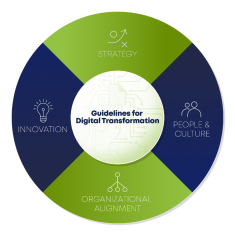By Yehudah Sunshine, Head of PR, odix
With the workforce going remote and IP existing almost exclusively in the digital domain enterprises, local and federal agencies, and SMBs alike are all striving to find the right digital blend to meet their industry transformation needs.
Supercharged by the Covid-19 pandemic, businesses in all sectors have been increasingly demanded to ‘digital transform’ and somehow mitigate all the evolving risks and regulatory expectations they face in the cyber battlefield. While the drive towards digital transformations has now become commonplace, its tangible achievements may be difficult to be seen.
From incorporating innovative technology and security protocols to protect their assets, digital transformation is the process of optimizing new and existing technologies, fluid ways of thinking, and automation heavy processes to mitigate human error and cyber risk.
What is a Digital Transformation?
For many, digital transformations mark a critical readdress of how their organization manages technology, process, and most importantly the individuals responsible for integrating new business models and new revenue streams. The end goal of all of these is drastically alter driven customer expectations around products and services, changing brand image and technical capacity in the process.
For those who operate in traditional goods, this transformation entails building digital products, such as a mobile application or an e-commerce platform.
What does it take to reach digital transformation?

According to McKinsey, regardless of the public push towards digital transformation very few have achieved this goal. “Years of research on transformations has shown that the success rate for these efforts is consistently low: less than 30 percent succeed. This year’s results suggest that digital transformations are even more difficult with Only 16 percent of respondents say their organizations’ digital transformations have successfully improved performance and equip them to sustain changes in the long term.”
Talk is cheap. In practice, top-down directives only achieve their aims if the process is well defined, and the objectives are clear. In the case of digital transformation, this means compartmentalizing which segments stand to gain the most through digitalization and defining the core technologies and vendors whose implementation meets a strategic need.
When the partners and solutions have been identified, the organization are then positioned to set realistic short-term and long-term goals to determine success based on predefined KPI.
Importance of security layers within Digital Transformation
Ingraining security capabilities at every step of the digital transformation is the key to mitigating cyber risks in the future. Just like you wouldn’t build a house and then add the plumbing and electrical after the fact when building towards digital transformation, organizations must focus on the technologies, cybersecurity education, and industry best IT practices that lay the groundwork for cybersecurity from square one.
From implementing encryption and mandatory policies on prohibited email attachments to offering regular training sessions and focusing on skills-based approaches vs fear-mongering, the digital transformation process can result in a higher level of security systemwide.
Metrics for success?
Effectively integrating new technologies, innovative processes, and industry best protocols takes time, money and a qualified staff of well-trained employees to do it right.
Digital transformation is not like a boxing match. While they both are hard-fought battles, only one gets the privilege of being judged by an outside panel of experts with a clear winner crowned at the end.
For digital transformation, measures of success may not be as clear cut as a knockdown, but they can be as straightforward as:
The name of the game in analyzing your KPI is to keep them simple, easy to gauge on a year-to-year basis, and directly linked to business productivity.
Guidelines for success
Realizing an effective digital transformation strategy involves tough choices, and long hours implementing new technology but more importantly ensuring buy-in from strategic partners across the organization.
Through clear vision and careful planning, the digital transformation process will be difficult to implement but more than pay dividends in the value it achieves and security it assures to organizations of any size.
Ensuring a secure digital transformation can most directly be tied to:
- Capacity building for the future workforce
- Implementing and updating day to day tools and processes
- Investing in staff education to manage and optimize new technology
- Demanding leadership prioritize and implement best-in-class technology to streamlines workflows and decrease human error.
About the Author
 Yehudah Sunshine Head of PR at Odix
Yehudah Sunshine Head of PR at Odix
Bringing together his diverse professional cyber know-how, intellectual fascination with history and culture, and eclectic academic background focusing on diplomacy and the cultures of Central Asia, Yehudah Sunshine keenly blends his deep understanding of the global tech ecosystem with a nuanced worldview of the underlying socio-economic and political forces which drive policy and impact innovation in the cyber sectors. Yehudah’s current work focuses on how to create and enhance marketing strategies and cyber driven thought leadership for odix (www.odi-x.com), an Israel-based cybersecurity start-up. Sunshine has written and researched extensively within cybersecurity, the service sectors, international criminal accountability, Israel’s economy, Israeli diplomatic inroads, Israeli innovation and technology, and Chinese economic policy.
Credit: Source link


Comments are closed.